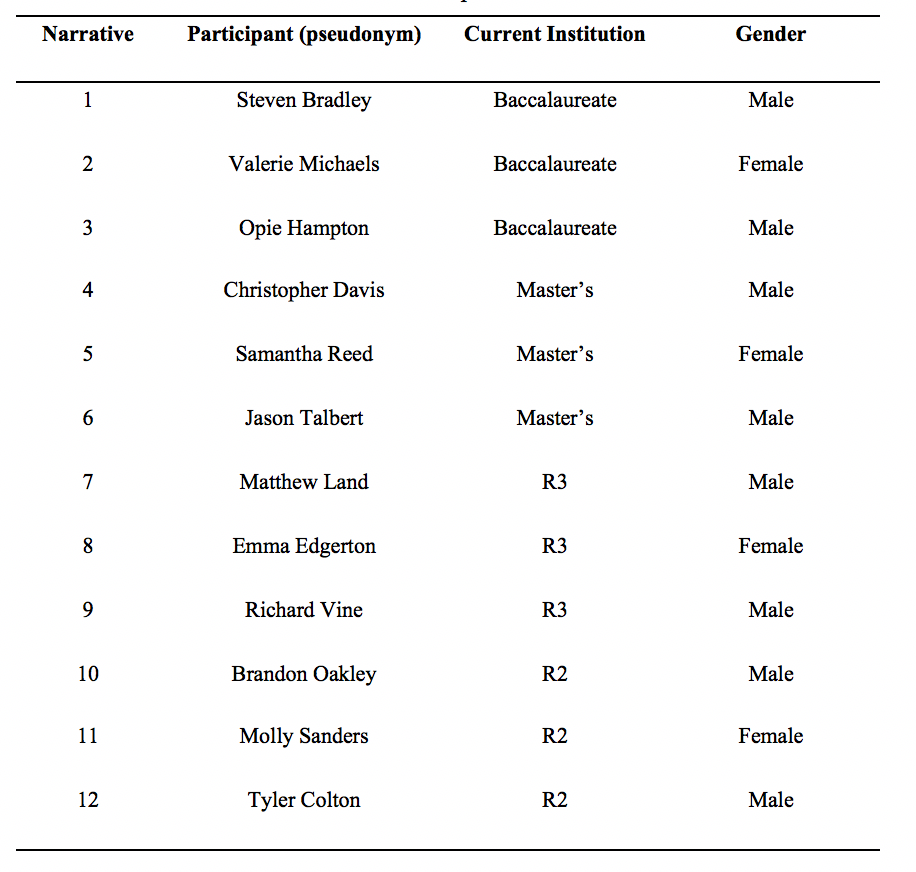In my dissertation, Swimming Upstream: Pathways of New Engineering Faculty at non-R1 Institutions, I examined the pathways and experiences of engineering professors with a focus on their graduate school experiences and teaching preparation. The excerpts below are directly from my dissertation. One of the main reasons I conducted this particular study and created the narratives below was to share these stories. I hope that by sharing these stories, more graduate students will become aware of the various faculty pathways that are possible in academia, and feel empowered to choose a path that is right for them.
I would love to hear from you if you read the narratives. Please send a brief note with your comments, reactions, or reflections to nbuswell@uci.edu.
—
The Co-Constructed Narratives
Each narrative was organized into major sections that are consistent across each narrative, but the narratives can be read individually or as a group. The four sections are: “How I got here,” “My preparations for teaching,” “My early days as a professor and what I am doing now,” and “What tenure looks like here.” Some narratives additionally have a fifth section, “Other thoughts,” for considerations that were important to include but did not fit within the other themes.
The narratives were constructed by me, Natascha Buswell. However, they were written in first-person from the perspectives of my participants. This was done intentionally, so that the narratives could act as the stories of more competent others (Chaiklin, 2003) to better convey the stories of engineering faculty at institutions of varying research and teaching activity, particularly to current graduate students and faculty. Since the stories of people taking a path less traveled in engineering academe are not well known, I wanted each narrative to stand alone and tell each participant’s story, as well as enable comparison and contrast with the other narratives. Readers might connect with the participants’ stories as well as see how the stories are similar to and different from one another, as well as other stories of pathways and perseverance.
Although the narratives are written in first-person, I was not able to capture everything about each person. Each narrative is meant to convey the way in which each participant told her or his story. Direct quotations from the interviews dominate the narratives and my words (Natascha’s) that are used for deidentification, clarity, and flow are indicated by brackets. By hearing the story in the participant’s words, the narratives will function as a conversation with the reader.
Since all of the narratives were deidentified to protect the participants’ privacy, the names of schools were changed to very generic versions indicating when the participant was at that school. For example, each participant went to “Undergraduate Institution.” The institution that the participant is at currently is called “Current Institution.” Each institution is also described by its Carnegie classification the first time it is referenced in the narrative.
Each narrative is based on a 90- to 120-minute interview with each individual participant. After I transcribed the audio interviews, I identified critical incidents (Webster & Mertova, 2007) in the transcriptions. I organized each narrative into major themes that are consistent across each narrative, but the narratives can be read individually or as a group. The transcripts were coded verbatim, which means word for word, except for the exclusion of crutch words and phrases, such as “umm”, “you know”, and any instances of stuttering.
Once the first draft for each narrative was constructed, I asked each participant to examine the draft and check for any inconsistencies or misrepresentations. I also asked the participants to comment on their thoughts regarding the incidents that I highlighted; I wanted to make sure they felt that the narrative represented their story accurately, both from a factual and emotional perspective. In some cases, a participant may have adjusted some wording and/or added additional thoughts. These modifications are included; however, they are not differentiated from the interview transcriptions. All the narratives were approved for publication by the participants.
The twelve narratives are presented in the following order, organized by institution type, as shown in the table below. Each narrative is organized into four sections: 1) “How I got here,” 2) “My preparations for teaching,” 3) “My early days as a professor and what I am doing now,” and 4) “What tenure looks like here.” Some narratives additionally have a fifth section, 5) “Other thoughts,” for considerations that were important to include but did not fit within the other sections.
PDF Files of the narratives can be accessed by clicking the names below:
Narrative 2 – Valerie Michaels
Narrative 4 – Christopher Davis
Note:
The above text and table are reprinted with permission from Buswell, N. T. (2017). The co-constructed narratives. In Swimming upstream: Pathways of new engineering faculty at non-R1 institutions (Doctoral dissertation). Pages 108 – 110.
References:
Chaiklin, S. (2003). The zone of proximal development in Vygotsky’s analysis of learning and instruction. Vygotsky’s educational theory in cultural context, 1, 39-64.
Webster, L., & Mertova, P. (2007). Using narrative inquiry as a research method: An introduction to using critical event narrative analysis in research on learning and teaching. New York, NY: Routledge.

